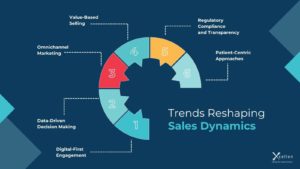Introduction
The life sciences industry stands at a pivotal juncture, facing a landscape transformed by global events and technological advancements. As we move forward in this new era, the traditional paradigms of sales and marketing in the sector are undergoing a significant metamorphosis. This blog intends to explore the emerging trends redefining how life sciences companies connect with healthcare professionals, patients, and key stakeholders in an increasingly digital and patient-centric world.
The aftermath of the COVID-19 pandemic has catalysed changes that were already simmering beneath the surface of the life sciences sector. We’re witnessing a seismic shift in expectations from both patients and healthcare providers. The demand for more accessible, personalised, and technologically integrated healthcare solutions has surged, compelling companies to rethink their engagement strategies. Concurrently, the industry is experiencing waves of consolidation, creating a more complex and competitive marketplace for sales teams to navigate.
Why is it important to adapt to these changes?
In this rapidly evolving ecosystem, the ability to adapt is not just advantageous – it’s essential for survival and growth. Life sciences organisations are being called upon to reimagine their sales approaches, moving beyond the conventional reliance on face-to-face interactions. The future of sales in this sector lies in embracing innovative methodologies that harness the power of digital technologies, leverage data-driven insights, and respond nimbly to the changing needs of a diverse stakeholder base.
As we delve deeper into the trends shaping the future of sales in the life sciences sector, it becomes evident that success will hinge on an organisation’s ability to blend traditional relationship-building skills with cutting-edge technological solutions.
Key Trends Impacting Sales Strategy
The life sciences sector is experiencing a paradigm shift in sales strategies, driven by several interconnected trends. These developments are reshaping how companies approach customer engagement, product promotion, and market penetration.
According to research conducted by KPMG across 100 sales leaders in Biotech and pharma, it was found that they had significantly improved upon their go-to-market strategy. The results revealed that 70% had invested in hybrid (in-person/digital sales) models, and 66% increased remote and digital interaction. And over 90% turned to technology that helped retrieve high-quality data for sharper insights, targeting, and measurement.

- Digital-First Engagement
The digital revolution has fundamentally altered the landscape of life sciences sales. Healthcare professionals (HCPs) and patients alike are increasingly comfortable with digital interactions, leading to a shift towards:
- Virtual meetings and webinars
- Digital content delivery platforms
- AI-powered chatbots for immediate customer support
- Augmented and virtual reality for product demonstrations
This digital-first approach allows for more frequent, targeted, and cost-effective interactions with stakeholders.
- Data-Driven Decision Making
The abundance of data available to life sciences companies is transforming sales strategies. By leveraging big data and analytics, sales teams can make more informed decisions and tailor their approaches for maximum impact.
- Advanced analytics for customer segmentation and targeting
- Predictive modelling to anticipate market trends and customer needs
- Real-world evidence to support product efficacy claims
- Personalised marketing based on individual HCP preferences and behaviours
- Omnichannel Marketing
The modern HCP expects a seamless experience across multiple touchpoints. Omnichannel marketing in life sciences involves:
- Coordinated messaging across digital and traditional channels
- Personalised content delivery based on individual preferences
- Integration of medical science liaison teams with sales efforts
- Consistent brand experience across all interactions
- This approach ensures that HCPs receive relevant information through their preferred channels, enhancing engagement and trust.
- Value-Based Selling
With increasing pressure on healthcare budgets, the focus has shifted from product features to demonstrable value:
- Emphasis on health outcomes and cost-effectiveness
- Collaborative partnerships with healthcare providers and payers
- Development of value-added services beyond the product
- Integration of real-world evidence into sales narratives
Sales teams must now articulate not just the clinical benefits of their products, but also their broader value to the healthcare ecosystem.
- Regulatory Compliance and Transparency
In an era of increased scrutiny, compliance and transparency have become paramount:
- Stringent adherence to evolving regulations (e.g., GDPR, Sunshine Act)
- Implementation of robust compliance training programs
- Transparent reporting of interactions with HCPs
- Ethical considerations in digital engagement and data use
Sales strategies must be designed with compliance at their core to maintain trust and avoid regulatory pitfalls.
- Patient-Centric Approaches
The rising influence of patients in healthcare decisions is shaping sales strategies:
- Development of patient support programs
- Engagement with patient advocacy groups
- Focus on patient education and empowerment
- Incorporation of patient feedback into product development and marketing
Sales teams are increasingly required to understand and address patient needs alongside those of HCPs.

These trends are not isolated; they interact and reinforce each other, creating a complex environment that demands agility and innovation from life sciences sales organisations. The journey ahead may be challenging but is filled with potential. By staying abreast with these trends and continuously evolving their strategies, life sciences companies can ensure they remain at the forefront of innovation, delivering value to all stakeholders in this vital industry.





